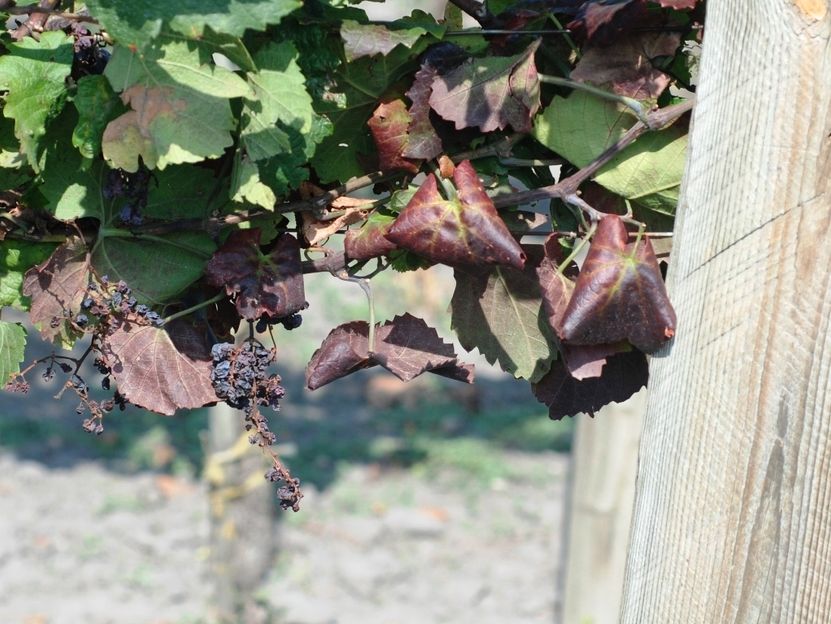Vine pest is genetically variable
Exactly 14 different variants of a very specific bacterium that damages grapevines can be found in Austria. This is one of the key results of a project supported by the Austrian Science Fund FWF, which looked at the damage caused to vines by phytoplasmas.

Some heard it through the grapevine, others saw the publication. A recent project by the FWF found that vine-infecting phytoplasmas are genetically variable in Austria.
Günter Brader
For plant pathologists, phytoplasmas represent the “sinister forces”: they are linked to over 100 plant diseases. Up until now, however, it has not been possible to culture them in the lab. It is therefore almost impossible to conduct experiments on these bacteria, which lack a cell wall. A team in the Health & Environment Department at the AIT Austrian Institute of Technology together with the “Höhere Bundeslehranstalt und Bundesamt für Wein- und Obstbau” (Education and Research Centre) in Klosterneuburg have now managed to analyse in greater detail a phytoplasma commonly found in Austrian vineyards – and came up with some surprising results.
From type to type
A key aspect of the project headed by Günter Brader was the isolation and characterisation of the DNA in very specific phytoplasmas: those that are responsible for a yellowing disease of vines known as the black wood of grapevine (Bois Noir). Günter Brader explains the particular challenge facing the team in the interview with scilog: “As there are no lab cultures of phytoplasmas, we first isolated the entire DNA of the infested host plants. This resulted in a mix of plant and bacterial DNA. Thanks to a specific composition of phytoplasma DNA we were able to separate these using special methods.” Once isolated, the team was able to start characterising the DNA. Surprisingly, subsequent comparisons of specific DNA sequences showed that there are at least 14 genotypes – genetically different phytoplasmas.
From stinging nettles to wine
Further studies showed that a currently rampant expansion of Bois Noir in Austria is caused by a single one of these 14 genotypes. “Two-thirds of all diseases can be traced back to this one genotype alone”, explains Günter Brader. This type is spread by a specific cicada (“Hyalesthes obsoletus”) whose alternate host is the stinging nettle. The clarification of this way of spreading was surprising as previous studies had identified other routes. “The way of spreading could have changed in recent years”, believes Günter Brader from the AIT, whose findings will now make an important contribution to tackling this problem.
Comparing infections
In a second part of the project, model plants (tomatoes and periwinkle rootstock) were infected with a total of six genotypes of the phytoplasma. The aim of this step was to study whether the different genotypes would cause the same or different symptoms in the plants. In fact, the strains displayed markedly different symptoms. Commenting on this development, Günter Brader says: “We assume that so-called effectors are responsible for these different symptoms. These are proteins that are released by the bacteria to the host cell and in this way support the infection process.”
Defence mechanisms
The team was also interested in the plant’s defence mechanisms. The effect of salicylic acid, a known plant defence compound on the model plants was examined. This showed that this had apparently little influence on the vulnerability of the plants. Tomato plants which could not accumulate any salicylic acid were thus infected. If this acid is to play an important role in tackling phytoplasmas, these plants would have to be significantly more prone to an infection – yet in fact they did not display any differences compared to the unchanged forms. The researchers also analysed whether a previous treatment with other bacteria would have any kind of effect on the infection – and in this way provide a way of fighting the biological pest. However, the results here were sobering: a single bacterial species (“Bacillus atrophaeus”) delayed the emergence of symptoms of the disease and reduced the number of phytoplasmas in the plant – but the intensity of the symptoms remained the same.
These findings about distribution paths and courses of infection provide important insights into the possibility of fighting these pests and form the necessary basis for making targeted and efficient interventions.
Original publication
A. Aryan, G. Brader, J. Mörtel, M. Pastar, M. Riedle-Bauer; "An abundant ‘Candidatus Phytoplasma solani’ tuf b strain is associated with grapevine, stinging nettle and Hyalesthes obsoletus"; European Journal of Plant Pathology; 2016
Amal Aryan, Rita Musetti, Monika Riedle‐Bauer, Günter Brader; "Phytoplasma Transmission by Heterologous Grafting Influences Viability of the Scion and Results in Early Symptom Development in Periwinkle Rootstock"; J of Phytopathology; 2016






















































